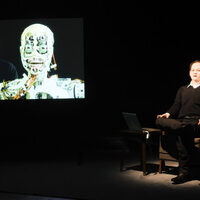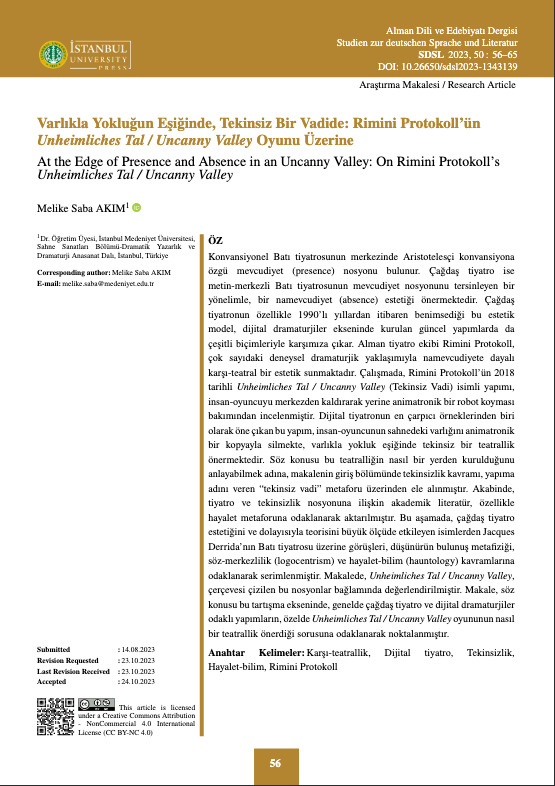At the Edge of Presence and Absence in an Uncanny Valley: On Rimini Protokoll’s Unheimliches Tal / Uncanny Valley
Item
- Titre (article, livre complet, chapitre de livre, publication réseaux sociaux, pageWeb, SiteWeb complet, etc.)
- At the Edge of Presence and Absence in an Uncanny Valley: On Rimini Protokoll’s Unheimliches Tal / Uncanny Valley
- Auteur de la référence bibliograpique
- Melike Akım
- Date de publication (AAAA ou AAAA-MM-JJ)
- 2023
- Numéro (revues scientifiques)
- 50
- Maison d'édition / Nom de la revue scientifique / Nom du site Web / Nom de l'institution universitaire (thèses) / Institution d'un rapport, etc.
- Studien zur deutschen Sprache und Literatur
- Intervalles des pages (articles)
- 56-65
- a comme concept
- Théâtre
- Vallée de l'étrange
- Intelligence artificielle
- Mise en scène de l’absence
- Arts trompeurs
- E-mail de la personne ayant créé cette référence bibliographique
-
 Julie-Michèle Morin
Julie-Michèle Morin
- Abstract
- <p>Conventional Western theatre is based on the Aristotelian notion of presence. Contemporary theatre, however, proposes an aesthetic of absence. Its orientation differs from the notion of presence found in text-centred Western theatre. This aesthetic model, adopted by contemporary theatre since the 1990s, also appears in various forms in current productions based on digital dramaturgies. Rimini Protokoll, a German theatre company with many experimental approaches, presents an anti-theatrical aesthetic based on absence. This study analyses Rimini Protokoll’s 2018 <em>Unheimliches Tal / Uncanny Valley</em> in terms of removing the human actor from the centre and replacing him with an animatronic robot. This production, which stands out as one of the most striking examples of digital theatre, erases the presence of the human actor on stage with an animatronic copy, proposing an uncanny theatricality that oscillates between presence and absence. To understand how this theatricality is constructed, the concept of the uncanny is analysed in the introductory part of the article through the metaphor of the “uncanny valley.” Subsequently, the academic literature on theatre and the notion of the uncanny is presented, with a particular focus on the metaphor of the ghost. The following section presents Jacques Derrida’s views onWestern theatre, focusing on his concepts of the metaphysics of presence, logocentrism, and hauntology. The article examines <em>Unheimliches Tal / Uncanny Valley</em> in the context of those concepts and then concludes with a consideration of the theatricality of this production in relation to contemporary theatre productions and digital dramaturgies.</p>
- doi
- 10.26650/sdsl2023-1343139
- short title
- At the Edge of Presence and Absence in an Uncanny Valley
- Source
- Instanbul University Press Web Site
- Date Submitted
- 2025-03-07T21:11:22Z
Linked resources
| Title | Class |
|---|---|
 Uncanny Valley Uncanny Valley |
Event |
Annotations
There are no annotations for this resource.

